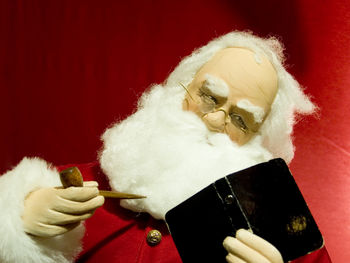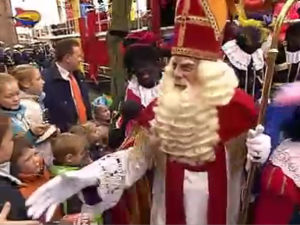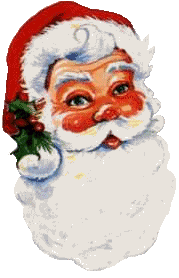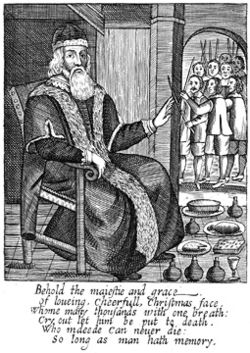
Santa Claus, Saint Nicholas, Saint Nick, Father Christmas, Kris Kringle, Santy, or simply Santa is a gift-giving figure in various cultures who distributes presents to children, traditionally on Christmas Eve. The popular American form Santa Claus originated as a mispronounciation of Dutch Sinterklaas, which is a contracted form of Sint Nicolaas (Saint Nicholas).
Father Christmas is a well-loved figure in many countries and predates the "Santa Claus" character. "Father Christmas" is similar in many ways, though the two have quite different origins. Using 'Santa' in places that predominantly call him 'Father Christmas' is often viewed as an Americanism and is quite rare, although they are generally regarded as the same character. Father Christmas is also present instead of "Santa" in Albania ("Babadimri"), Armenia ("Gaghant Baba"), Denmark ("Julemanden"), Italy ("Babbo Natale"), Lithuania ("Kalėdų Senelis"), Brazil ("Papai Noel"), Czech Republic ("Ježíšek"), Poland ("Święty Mikołaj"), Portugal ("Pai Natal"), Romania ("Moş Crăciun"), Germany ("Weihnachtsmann" or "Nikolaus"), Greece ("Άγιος Βασίλης") Scottish Highlands ("Daidaín na Nollaig"), France and French Canada ("Le Pčre Noël"), Ireland ("Daidí na Nollaig"), Finland ("Joulupukki"), Norway ("Julenissen"), Sweden ("Jultomten"), Bulgaria ("Dyado Koleda"), Turkey ("Noel Baba"), Serbia and Bosnia and Herzegovina ("Deda Mraz"), Spain and Latin America ("Papá Noel"), Afghanistan ("Baba Chaghaloo"), Iraq and South Africa ("Vader Kersfees"), Chile (Viejo Pascuero), Egypt ("Papa Noël") ,Iran ("Baba Noel").
In October of 2006 USA Today listed Santa Claus (St. Nick) as #4 on their list of Imaginary Luminaries: the 101 most influential people who never lived.[1]
Contents |
Overview
Santa Claus is a variation of a Dutch folk tale based on the historical figure Saint Nicholas, a bishop from Turkey (then known as Myra), who gave presents to the poor. His charity became legend when a man lost his fortune and found himself incapable of supporting his three daughters, who would not be able to find husbands as they lacked dowries. This man was going to give them over to a life of prostitution; however, St. Nicholas provided them with gold, enabling them to retain their virginal virtues and marry.

This inspired the mythical figure of Sinterklaas, the subject of a major celebration in the Netherlands and Belgium, Germany (where his alleged date of death, December 6, is celebrated the evening before on December 5), which in turn inspired both the myth and the name of Santa Claus (actually a mispronunciation of the Dutch word "Sinterklaas" by the English settlers of New Amsterdam (later renamed New York). Whilst in those countries Saint Nicholas is celebrated as a distinct character with a religious touch, Santa Claus is also making inroads as a symbol during Christmas.
He forms an important part of the Christmas tradition throughout the Western world and Japan and other parts of East Asia.
In many Eastern Orthodox traditions, Santa Claus visits children on New Year's Day and is identified with Saint Basil whose memory is celebrated on that day.
Depictions of Santa Claus also have a close relationship with the Russian character of Ded Moroz ("Grandfather Frost"). He delivers presents to children and has a red coat, fur boots and long white beard. Much of the iconography of Santa Claus could be seen to derive from Russian traditions of Ded Moroz, particularly transmitted into western European culture through his German folklore equivalent, Väterchen Frost.

Conventionally, Santa Claus is portrayed as a kindly, round-bellied, merry, bespectacled white man in a red coat trimmed with white fur (perhaps remotely derived from the episcopal vestments of the original Bishop Nicholas), with a long white beard and green or white gloves. On Christmas Eve, he rides in his sleigh pulled by flying reindeer from house to house to give presents to children. To enter the house, Santa Claus comes down the chimney and exits through the fireplace. During the rest of the year he lives together with his wife Mrs. Claus and his elves manufacturing toys. Some modern depictions of Santa (often in advertising and popular entertainment) will show the elves and Santa's workshop as more of a processing and distribution facility, ordering and receiving the toys from various toy manufacturers from across the world. His home is usually given as either the North Pole, in northern Canada, Korvatunturi in Finnish Lapland, Dalecarlia in Sweden, or Greenland, depending on the tradition and country. Sometimes Santa's home is in Caesarea when he is identified as Saint Basil. L. Frank Baum placed his home in The Laughing Valley of Hohaho.
Historical origins
See also: Christmas gift-bringers around the world and Christmas worldwide
Santa Claus in popular culture

Santa Claus rituals
Several rituals have developed around the Santa Claus figure that are normally performed by children hoping to receive gifts from him. See main article: Santa Claus rituals.
Ho, ho, ho
Ho ho ho is the way that many languages write out how Santa Claus laughs. "Ho, ho, ho! Merry Christmas!"
The laughter of Santa Claus has long been an important attribute by which the character is identified, but it also does not appear in many non-English-speaking countries. The traditional Christmas poem A Visit from St. Nicholas relates that Santa has:
- . . . a little round belly
That shook when he laugh'd, like a bowl full of jelly
Ho ho ho represents an attempt to write the deep belly-laugh of Santa Claus, as opposed to the conventional, higher-pitched ha ha that represents the laughter of thinner characters, or the snickering, cynical bwa ha ha! associated with the villains of melodrama.
Jacob Grimm asserts that "Ho ho ho" was the hunting cry of Odin during The Furious Host. Odin being attributal to Santa Claus.
"H0H 0H0" is a postal code used by Canada Post for routing letters sent in Canada to Santa Claus at the North Pole. The alphanumeric sequence falls within a grouping associated with the Montreal, Quebec area.
Santa Claus reindeers' name
Dasher, Dancer, Prancer, Vixen, Comet, Cupid, Donner, and Blitzen are the most commonly cited names of Santa's eight reindeer. In the original Clement C. Moore poem "The Night Before Christmas", from which the names of the reindeer came, the reindeer known today as Donner and Blitzen were originally Dunder and Blixem. Dunder was later reprinted as Donder, which developed into Donner; while Blixem quickly became Blixen and then Blitzen.[2]
Rudolph the Red-Nosed Reindeer was created for Montgomery Ward in 1939, and has since entered the public consciousness as Santa's ninth reindeer.
Santa Claus on film
Christian opposition to Santa Claus
Also see main article: Secularization of Christmas

Despite Santa Claus's mixed Christian roots, he has become a secular representation of Christmas. As such, a small number of primarily fundamentalist Christian churches dislike the secular focus on Santa Claus and the materialist focus that present-receiving gives to the holiday.
People who condemn the Santa-ization of Christmas are in the minority.
Such a condemnation of Santa Claus is not a twentieth century phenomenon, but originated among some Protestant groups of the 16th century and was prevalent among the Puritans of 17th century England and America who banned the holiday as either pagan or Roman Catholic. Following the English Civil War, under Oliver Cromwell's government Christmas was banned. Following the Restoration of the monarchy and with Puritans out of power in England,[3] the ban on Christmas was satirized in works such as Josiah King's The Examination and Tryal of Old Father Christmas; Together with his Clearing by the Jury (1686) [Nissenbaum, chap. 1].
Rev. Paul Nedergaard, a clergyman in Copenhagen, Denmark, drew the ire of Danish citizens in 1958 when he declared Santa to be a "pagan goblin" after Santa's image was used on fundraising materials for a Danish welfare organization [Clar, 337]. One prominent religious group that refuses to celebrate Santa Claus or Christmas for similar reasons are the Jehovah's Witnesses, but several denominations of Christians have varying concerns about Santa Claus.
Some Christians would prefer that the focus of the Christmas season be placed on the actual birth of Jesus.[4] Some parents are uncomfortable about lying to their children about the existence of Santa. Some parents worry that their children might think that if they were deceived by their parents about Santa Claus, parents might also be deceiving them about the existence of God. Some in this group who still wish to participate in the festive gift-giving atmosphere of "Santa season" will shop for toys to donate to underprivileged children on St. Nicholas's feast day, December 6. This is an opportunity to instill the Christian value of secret charity, which Nicholas was known for. Although feast days are usually not acknowledged in Protestant denominations, this tradition has found acceptance there as well.
While these viewpoints do not represent the majority of Christians, their comments have drawn the attention of critics such as the fictional Landover Baptist Church, whose website satirizes and parodies this viewpoint. The website specifies that Satan is disguising himself as Santa (notice the same letters used in an anagram) to deceive people into a materialistic celebration.[5]
See also
- American Christmas traditions
- Christmas
- Christmas Eve
- German Christmas traditions
- Santa Claus parade
- Secularization of Christmas
Related figues:
External links
- "Official" Santa Claus site: Santa Claus
- Santa's Journal
- Santa Claus DVD Christmas Card from Santa Claus Main Post Office, Arctic Circle, Lapland, Finland Santa Claus Lapland
- The real Santa, St. Nicholas, with information, art, & fun activities: Saint Nicholas
- Christmas and Santa Claus by Santa Club
- The Original 1860s Thomas Nast Santa Claus Illustrations
- CLAIM: The modern image of Santa Claus was created by Coca-Cola. what do you think?
- Jenny Nyström, the artist whose Christmas cards inspired Haddon Sundblom when he designed Coca-Cola's Santa.
- Norman Rockwell's Santa and Expense Book
- Santa Post, A personal letter from Santa himself.
- SantaLand.com, one of the Internet's oldest Santa-related website, founded in 1991 by former Library of Congress archivist Jeff Guide
- Fortean Times magazine pieces together the Santa myth in Lappland
- NORAD Tracks Santa
- Santa Claus Plaza
- Santa Television, originating out of Rovaniemi in Finnish Lapland
- KringleQuest.com: The Unofficial Santa Claus: The Movie Website
- Santa Claus Pictures
- Santa Claus Vintage Postcards
- This American Life story about the history and stories of Santa Claus
- Santas Around the World Santa Claus Around the World Gallery at PPG Wintergarden
- Santa Claus Casino
References
- "Bad Disney". Washington Times. November 21, 2003.
- Barnard, Eunice Fuller. "Santa Claus Claimed as a Real New Yorker." New York Times. December, 19, 1926.
- Baum, L. Frank. The Life and Adventures of Santa Claus. 1902; reprint, New York: Penguin, 1986. ISBN 0-451-52064-5
- Belk, Russel W. "A Child's Christmas in America: Santa Claus as Deity, Consumption as Religion." Journal of American Culture, 10, no. 1 (Spring 1987), pp. 87-100.
- "Christmas Customs; Are They Christian?". The Watchtower (New York). December 15, 2000.
- Clar, Mimi. "Attack on Santa Claus." Western Folklore, 18, no. 4 (October 1959), p. 337.
- Clark, Cindy Dell. Flights of Fancy, Leaps of Faith: Children's Myths in Contemporary America. Chicago: University of Chicago Press, 1995. ISBN 0-226-10778-7
- "The Claus That Refreshes" at Snopes.com.
- "Letter from Santa Clause" at santabymail.com.
- "The Devil Is In Your Chimney!" at Landoverbaptist.org.
- Dini, Paul. Jingle Belle various issues [6]
- Flynn, Tom. The Trouble with Christmas. Buffalo, N.Y.: Prometheus Books, 1993. ISBN 0-87975-848-1
- Horowitz, Joseph. Classical Music in America: A History of Its Rise and Fall. New York: W. W. Norton, 2005. ISBN 0-393-05717-8
- "Is There a Santa Claus?" New York Sun. September 21, 1897.
- King, Josiah. The Examination and Tryal of Old Father Christmas; Together with his Clearing by the Jury . . . London: Charles Brome, 1686. Full text available here
- Lalumia, Christine. "The restrained restoration of Christmas". In the Ten Ages of Christmas at BBC.co.uk.
- [Moore, Clement Clarke]. "A Visit from St. Nicholas." Troy (N.Y.) Sentinel. December 23, 1823.
- Nissenbaum, Stephen. The Battle for Christmas. New York: Alfred A. Knopf, 1996. ISBN 0-649-41223-9
- Otnes, Cele, Kyungseung Kim, and Young Chan Kim. "Yes, Virginia, There is a Gender Difference: Analyzing Children's Requests to Santa Claus." Journal of Popular Culture, 28, no. 1 (Summer 1994), pp. 17-29.
- Ott, Jonathan. Pharmacotheon: Entheogenic Drugs, Their Plant Sources and History. Kennewick, Wash.: Natural Products Company, 1993. ISBN 0-9614234-9-8
- Plath, David W. "The Japanese Popular Christmas: Coping with Modernity." American Journal of Folklore, 76, no. 302 (October-December 1963), pp. 309-317.
- Potter, Alicia. "Celluloid Santas" at Factmonster.com.
- Quinn, Seabury. Roads. 1948; facsimile reprint, Mohegan Lake, N.Y.: Red Jacket Press, 2005. ISBN 0-9748895-8-X
- Romain Sardou's One Second before Christmas, 2005. ISBN 2-84563-262-2 (French original version)
- "St. Nicholas of Myra" in the Catholic Encyclopedia at NewAdvent.org.
- Sedaris, David. The Santaland Diaries and Seasons Greetings: Two Plays. New York: Dramatists Play Service, 1998. ISBN 0-8222-1631-0
- Shenkman, Richard. Legends, Lies, and Cherished Myths of American History. New York: HarperCollins, 1988. ISBN 0-06-097261-0
- Siefker, Phyllis. Santa Claus, Last of the Wild Men: The Origins and Evolution of Saint Nicholas, Spanning 50,000 Years. Jefferson, N.C.: McFarland, 1996. ISBN 0-7864-0246-6
- Twitchell, James B. Twenty Ads that Shook the World. New York: Crown Publishers, 2000. ISBN 0-609-60563-1
- "Why Track Him?" at NORADsanta.org.
Categories: Santa Claus | Christmas characters | Christmas traditions
